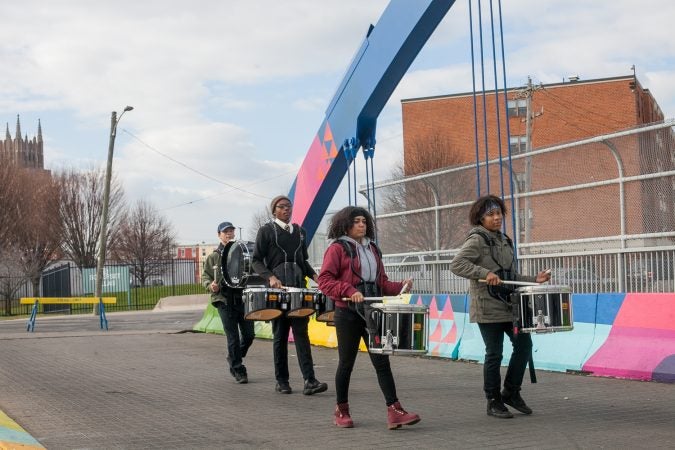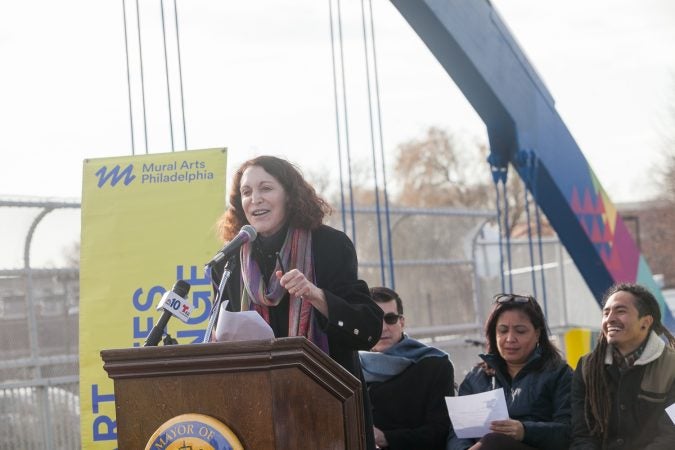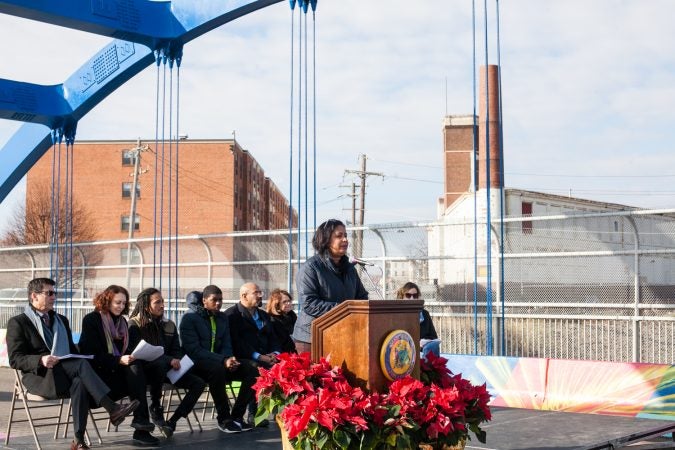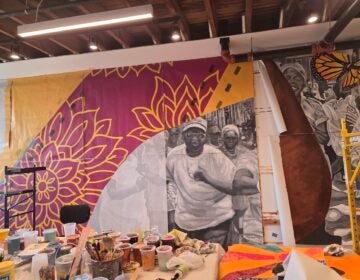Mural symbolizes new start, new life for former Kensington heroin camp
City Hall and neighbors hope the new mural on B Street Bridge will spur pride and revitalization in one of Philadelphia's most troubled places.
Listen 2:14-

Kensington High School for the Creative and Performing Arts students Ebany Centeno, Marvelis Lima, Laquan Drago and Michael Colon performed on the B Street Bridge in Kensington before the dedication ceremony for a recently completed mural on the bridge. (Brad Larrison for WHYY)
-

Kensington High School for the Creative and Performing Arts students Ebany Centeno, Marvelis Lima, Laquan Drago and Michael Colon performed on the B Street Bridge in Kensington before the dedication ceremony for a recently completed mural on the bridge. (Brad Larrison for WHYY)
-

Jane Golden,Executive Director of Mural Arts, opened the dedication ceremony for a new mural that was recently completed on the B Street Bridge in Kensington Tuesday. (Brad Larrison for WHYY)
-

Community members and students from Kensington High School for the Creative and Performing Arts stood and walked on the B Street Bridge during a dedication ceremony for the recently-completed mural on the bridge. (Brad Larrison for WHYY)
-

City Council Woman for the 7th District, Maria Quinones-Sanchez, spoke at the dedication ceremony for a new mural on the B Street Bridge in Kensington Tuesday. (Brad Larrison for WHYY)
-

A new mural was recently completed on the B Street Bridge in Kensington. (Brad Larrison for WHYY)
-

Lead artist Calo Rosa spoke at the dedication ceremony for the recently completed mural on the B Street Bridge in Kensington. (Brad Larrison for WHYY)
-

Lead artist Calo Rosa spoke at the dedication ceremony for the recently completed mural on the B Street Bridge in Kensington. (Brad Larrison for WHYY)
-

Lead artist Calo Rosa spoke at the dedication ceremony for the recently completed mural on the B Street Bridge in Kensington. (Brad Larrison for WHYY)
-

Jane Golden introduced members of the Youth Violence Reduction Parternship Guild who worked on the new mural recently completed on the B Street Bridge in Kensington. (Brad Larrison for WHYY)
-

Members of the Youth Violence Reduction Parternship Guild who worked on the new mural on the B Street Bridge in Kensington cut the ribbon at the end of a dedication ceremony Tuesday. (Brad Larrison for WHYY)
The newest mural in the city of Philadelphia adorns a bridge spanning what used to be an encampment of homeless drug users.
The B Street Bridge in Kensington, over the Conrail train tracks, had overlooked the site of a sprawling tent city and open-air drug market that was bulldozed over the summer. The mural project is backed by community services to help the neighborhood improve itself.
For decades, the area around the B Street Bridge in Kensington has been predominately Latino. Working with residents at a nearby senior residence operated by HACE, a Latino community development organization, Mural Arts Philadelphia designed a painting scheme that reflects the community’s heritage: bright colors, rosy sunsets and banana leaves you might find in the Caribbean.
“The structure itself is geometric shaped, so we needed to include that in the design,” said mural artist Calo Rosa. “The geometric patterns make a dynamic game with the colors.”
Recently, this neighborhood’s Caribbean heritage has taken a back seat to a horrific crisis. Last year, it gained national notoriety for the large, semi-permanent encampment of heroin users along the train tracks. Even though the city and Conrail officially cleaned up the site over the summer, Rosa said those addicts are still there.
He knows because they kept coming around to help him paint.
“Of course they are dealing with something,” said Rosa, who is originally from El Salvador. “But there is something positive about, ‘I can work on this. I can work on myself. Put me to do something so I can put my mind away, and focus on this instead of focusing on something else.’”
At a dedication ceremony, speakers from City Hall and the neighborhood noted that the new mural symbolizes new hope for the troubled neighborhood, where drugs and poverty have taken a heavy toll.
“It’s symbolic of the work to transform this neighborhood,” said city managing director Michael DiBerardinis. “To take the good, to take the sturdiness, to take the affection, to take the history and symbolize that here, in this spot, to lift it up and have it be a marker of hope.”
Councilwoman Maria Quiñones-Sánchez reiterated DiBerardinis’ pledge to stay engaged with the struggle for Kensington’s revitalization over the long haul. “This is an unusual situation,” she said. “We have to think outside the box.”
A crossing point
The bridge is more than symbolic: It’s a piece of infrastructure that connects two communities on opposite sides of the below-grade railroad tracks. The mural was painted with help from The Guild, a hired crew of young people recently released from prison. It’s part of Mural Arts Restorative Justice program.
One member of The Guild, Markees Quillen, recalled using the bridge as part of his drug trade.
“I was running across the bridge a million and one times, selling narcotics,” said Quillen, standing with this other Guild members. “We’re trying to help out the youth before they fall into our footsteps.”
As part of the project, Mural Arts Philadelphia opened a storefront nearby that offers social services, such as housing referrals and recovery programs, as well as art classes. It’s part of the Porch Light Project, in partnership with the city’s Department of Behavioral Health and Intellectual Disability services.
Mural Arts director Jane Golden said the Porch Light sites are in response to a four-year study done by Yale University on the effectiveness of public art projects.
“Something happens when we get ready to leave after doing a public art project,” said Golden. “We’ve tapped into the collective efficacy of a community, and people feel ready for more, and yet we’re going. Our work is in demand in other places.
“So we said, wait a minute, what if we could shift the paradigm better ourselves?” she said. “Open up a storefront where we offer everything from social services to a wide variety of art making.”
There are a few such storefronts around the city. Porch Light director Laure Biron says the Kensington site attracts a disproportionate number of neighborhood artists.
“Sometimes you have to think about a low barrier for the arts — they think, ‘I can’t draw or I’m not an artist,’ ” she said. “I find that as soon as we open the grates of the Kensington storefront, people are pouring in saying, ‘I’m an artist,’ and showing us artwork they’ve done on the back of newspapers, on cardboard, in sketchbooks.”
Biron says using art to build relationships with people in addiction recovery is an effective way to build trust and maybe get them to enroll in assistance programs they otherwise would avoid.
WHYY is your source for fact-based, in-depth journalism and information. As a nonprofit organization, we rely on financial support from readers like you. Please give today.





